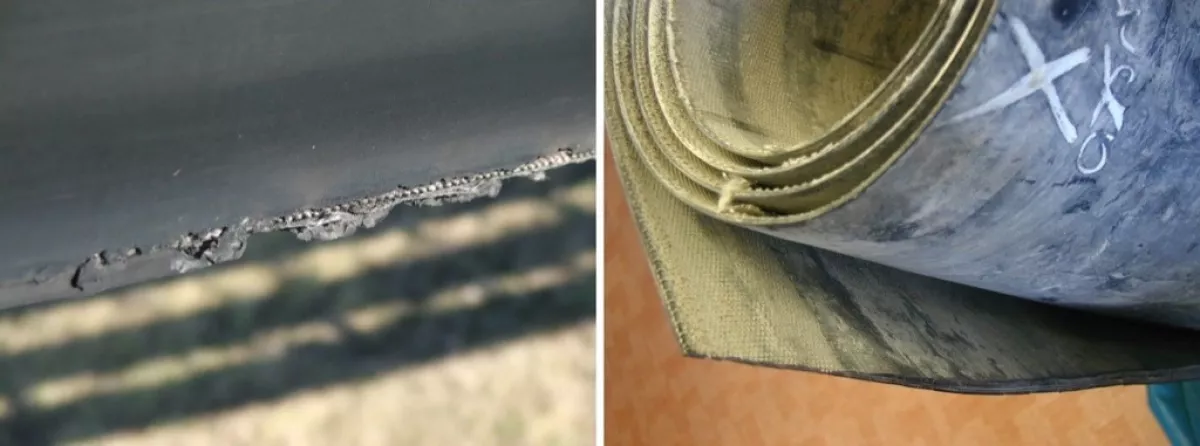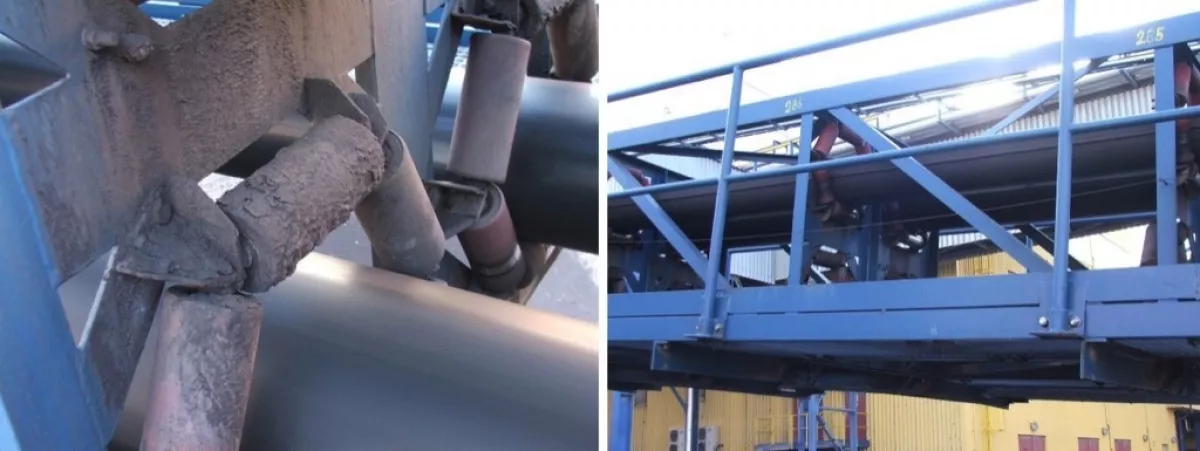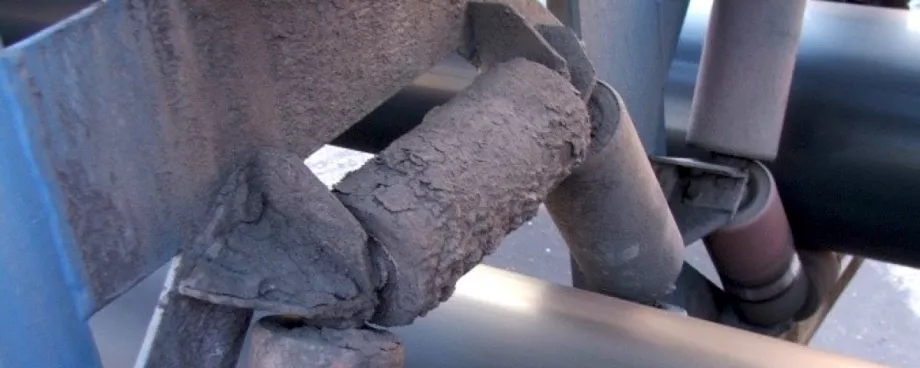Introduction
Wearing of a conveyor belt is an irreversible process without any possibility to avoid it within the operation of a belt conveyor, i.e. during transport of material using the belt conveyors. In general, it is possible to say that the irreversible changes, arising inside of the conveyor belt, are caused by physical, chemical, and biological influences.
A simultaneous acting of these three factors causes aging of the upper and bottom cover of the conveyor belt. Degradation of the conveyor belt rubber parts due to chemical or physical-chemical acting is called corrosion. The corrosion process can be accelerated in consequence of sunshine or temperature. Undesirable modification of chemical characteristics in some of conveyor belt parts is another negative process, which is called degradation.
The matter of conveyor belt wear is a specific research area, which is interesting both for producers and users of the conveyor belts. The conveyor belt manufacturers are applying various procedures in order to increase the conveyor belt durability [1]. There are applied special additives that are able to eliminate or to slow down significantly the individual undesirable processes. The applied additives are, for example, the antioxidants, antiozonants, UV-absorbers, stabilizers etc. The users of conveyor belts are trying to minimise the conveyor belt wearing by a maintenance system.
The main task of such maintenance system is to provide operational conditions that are able to keep the wear-out process on an acceptable level [2,3]. However, it is necessary to dispose of a large amount of information in order to apply an efficient maintenance system. The required sum of information is necessary for evaluation of the conveyor belt operational conditions or for warning against initialisation of possible undesirable processes [4].In this way, the conveyor belt operator will be able to undertake adequate measures in order to stop or to reduce development of the undesirable processes up to the acceptable level [5].
The above-mentioned questions are relevant for all types of conveyor belts, regardless of the conveyor belt construction, kind of the transported material or operational life [6,7]. However, there are possible also specific unfavourable operational states, which are occurring only in the case of a certain type of the belt conveyor and for other types of the belt conveyors they are almost negligible. A specific wear-out process is typical for a modern and innovative kind of the continuous conveying systems, namely for the pipe conveyors.
Conveyor Belts in Pipe Conveyors
The rubber-textile conveyor belts are used for installation in the pipe conveyors much more than steel-cord conveyor belts. The rubber-textile conveyor belts are suitable for most of the pipe conveyor installations with regard to the strength conditions during the pipe conveyor operation as well as with regard to other circumstances. The conveyor belts installed in pipe conveyors are subjected not only to an influence of the transported material, but they are also exposed to a specific loading, which is caused by a cyclic process of the conveyor belt closing into the piped shape and following opening of it into the flat shape. Important factors are also influences of the operational conditions, quality of maintenance, etc. All these facts are able to cause various damage of the conveyor belt gradually (Fig. 1).

Another possible negative phenomenon, which is occurring within the pipe conveyor operation, is such situation when the rubber-textile conveyor belt does not have a full or stable contact with all six idler rolls situated in the hexagonal idler housing (Fig. 2). This unfavourable situation is occurring in the straight sections of the pipe conveyor trajectory as well as in the sections curved horizontally and vertically. The negative result of this situation is a deformed shape of the conveyor belt cross-section, i.e. the flattened or even flat shape of the belt cross-section what means that the conveyor belt does not have the required dynamic properties and is damaged dynamically. The final result of this undesirable situation is a local increasing of intensity of the conveyor belt wear-out process, which causes a damage of the belt cover layers, higher motional resistances and a possibility of material spillage along the conveying trajectory, as well. All these facts are resulting in undesirable technical and economical consequences for pipe conveyor operator or user.

A special analysis was elaborated within the framework of the given investigation process in order to describe the above-mentioned undesirable behaviour of the conveyor belt and to observe changes occurring in the belt internal construction.
Characteristics of Rubber-Textile Pipe Conveyor Belt with Dynamic Damage

In order to investigate the individual mechanical characteristics of the rubber-textile conveyor belt, which was damaged dynamically, a set of measurements was performed within the framework of the investigation process, whereas some of the measured values were compared with a reference sample, i.e. a sample without a dynamic damage. The sample of the analysed conveyor belt was divided into two parts (due to a transport possibility), which are marked A and B (Fig. 3). The first measurement was specified for determination of the belt tensile strength measured in the longitudinal direction (Rm), belt expansibility measured in the longitudinal direction (Re) and relative elongation at the permissible tension level (σ) according to the standard STN ISO EN 283 – 1.
There were not recorded any relevant differences among the individual parts of the analysed rubber-textile conveyor belt with regard to the obtained values of the above-mentioned measured mechanical characteristics (Table 1).
| A Left | A right | B left | B right | |
|---|---|---|---|---|
| Rm [N/mm] | 1332 | 1336 | 1340 | 1342 |
| Re [%] | 16 | 16 | 16 | 16 |
| σ [%] | 0.8 | 1.0 | 0.9 | 0.8 |
The second measured set was oriented towards determination of the next mechanical characteristics: the elastic elongation (lp), plastic (durable) elongation (tt) and modulus of elasticity ε for individual parts of the investigated conveyor belt (Table 2).
| A left | A center | A right | B left | B center | B right | |
|---|---|---|---|---|---|---|
| Ip [%] | 0.5 | 0.4 | 0.3 | 0.4 | 0.3 | 0.4 |
| tt [%] | 0.7 | 0.5 | 0.5 | 0.6 | 0.6 | 0.6 |
| 0.6 | 13889 | 18519 | 20000 | 17241 | 17857 | 17241 |
There are visible, according to the results summarised in Table 2, considerable differences among the individual measured values, in particular among the individual values of the modulus of elasticity measured on the testing specimens separated from the various parts of the analysed conveyor belt sample. From this reason as well as with regard to the requirements of the following analysis there was performed the same set of measurements, but this time using the referential testing specimens, which were separated from a sample of the unused rubber-textile conveyor belt with the identical internal construction. The results from this measurement are summarised in Table 3.







